Project Quality Management Plan
VerifiedAdded on 2020/02/24
|9
|2627
|107
AI Summary
This assignment focuses on developing a Project Quality Management Plan. Students are tasked with outlining the processes, procedures, and tools to ensure the project deliverables meet defined quality standards. It requires understanding of risk management, quality control, and communication strategies for effective quality assurance throughout the project lifecycle.
Contribute Materials
Your contribution can guide someone’s learning journey. Share your
documents today.
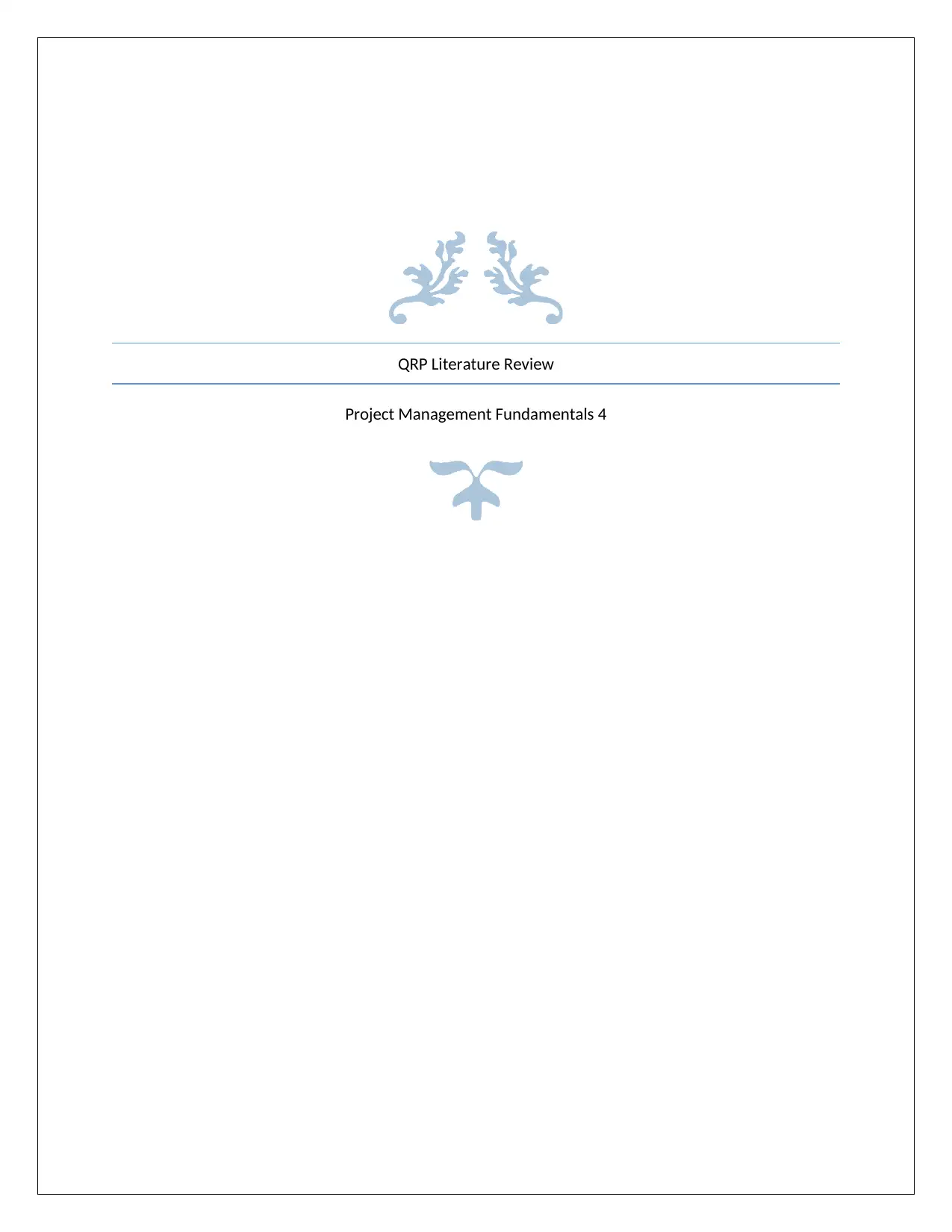
QRP Literature Review
Project Management Fundamentals 4
Project Management Fundamentals 4
Secure Best Marks with AI Grader
Need help grading? Try our AI Grader for instant feedback on your assignments.
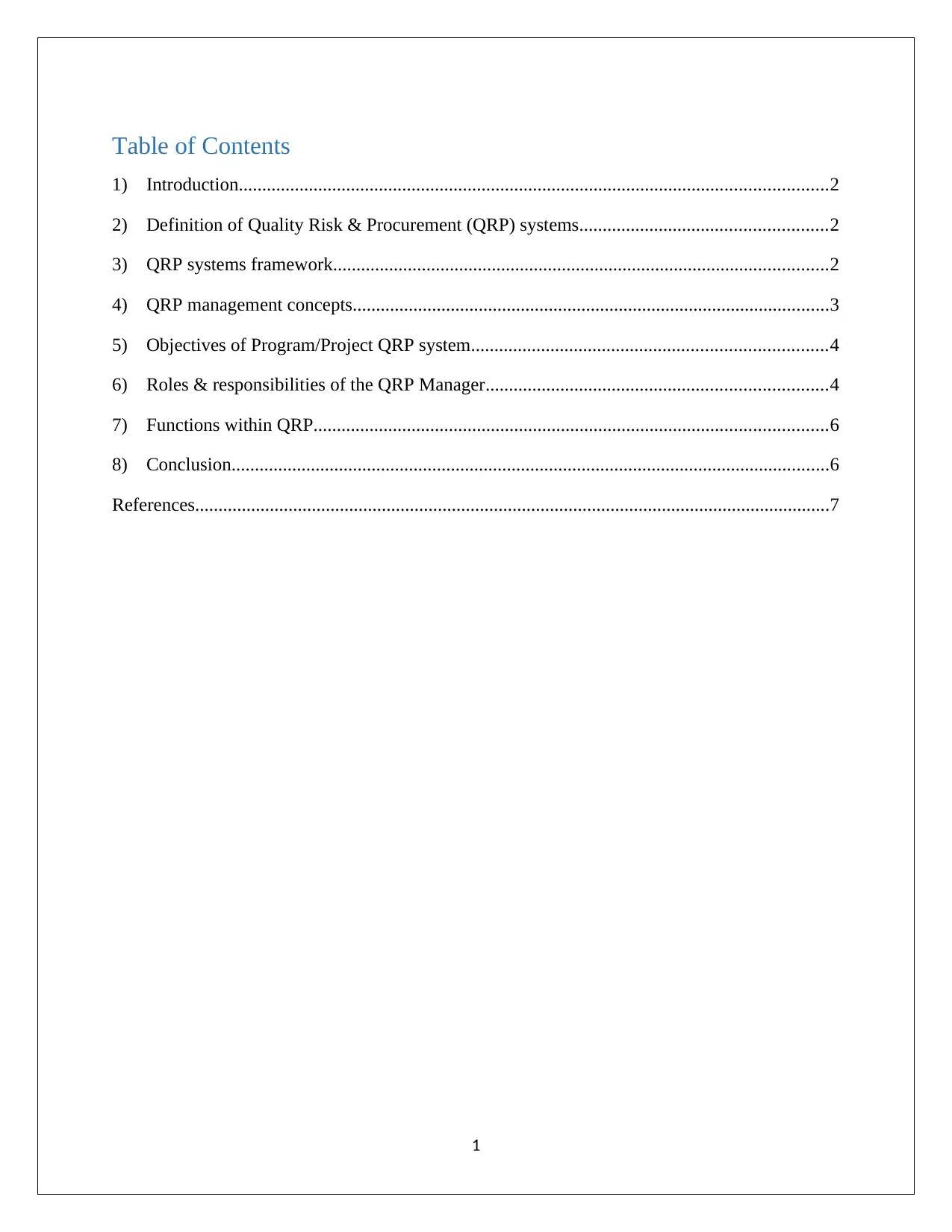
Table of Contents
1) Introduction..............................................................................................................................2
2) Definition of Quality Risk & Procurement (QRP) systems.....................................................2
3) QRP systems framework..........................................................................................................2
4) QRP management concepts......................................................................................................3
5) Objectives of Program/Project QRP system............................................................................4
6) Roles & responsibilities of the QRP Manager.........................................................................4
7) Functions within QRP..............................................................................................................6
8) Conclusion................................................................................................................................6
References........................................................................................................................................7
1
1) Introduction..............................................................................................................................2
2) Definition of Quality Risk & Procurement (QRP) systems.....................................................2
3) QRP systems framework..........................................................................................................2
4) QRP management concepts......................................................................................................3
5) Objectives of Program/Project QRP system............................................................................4
6) Roles & responsibilities of the QRP Manager.........................................................................4
7) Functions within QRP..............................................................................................................6
8) Conclusion................................................................................................................................6
References........................................................................................................................................7
1
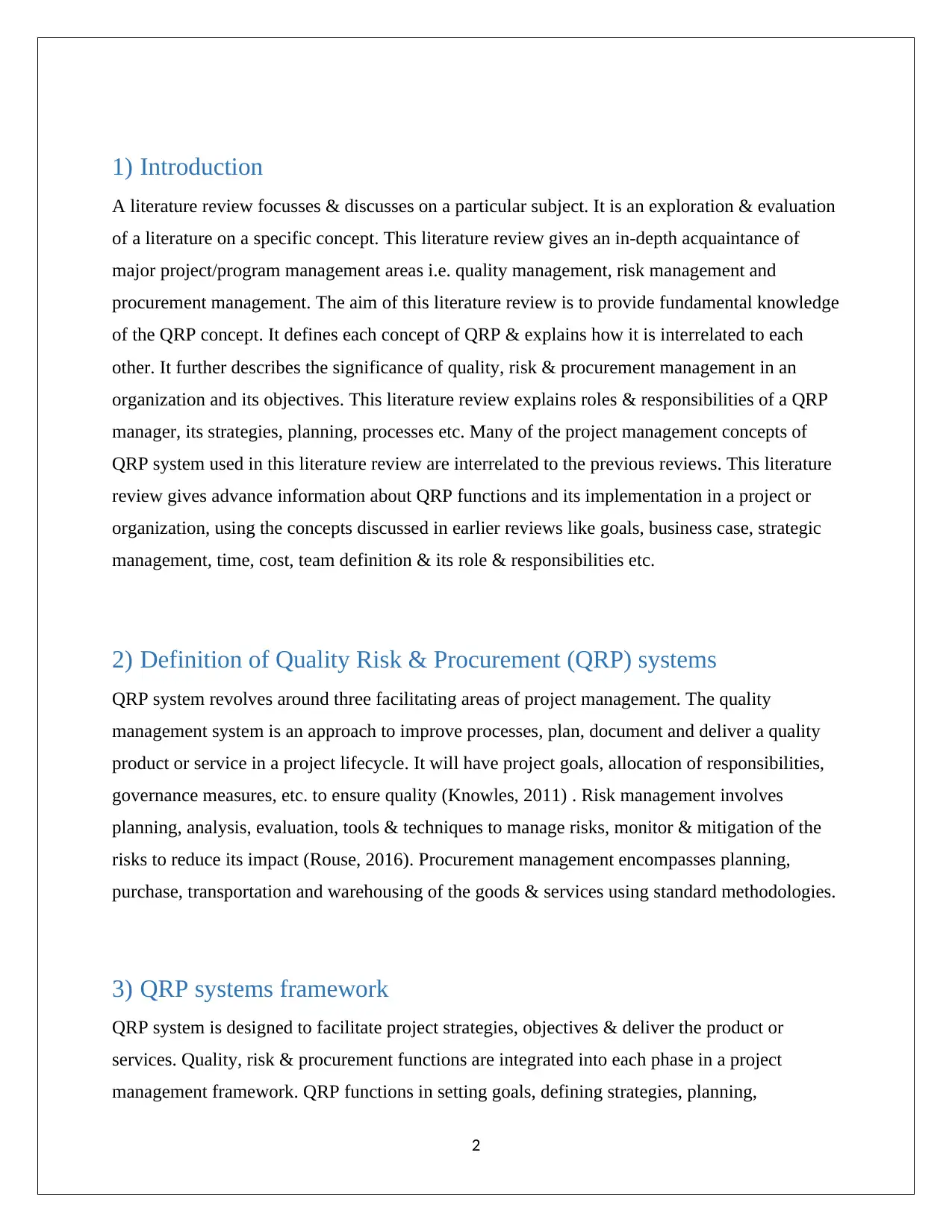
1) Introduction
A literature review focusses & discusses on a particular subject. It is an exploration & evaluation
of a literature on a specific concept. This literature review gives an in-depth acquaintance of
major project/program management areas i.e. quality management, risk management and
procurement management. The aim of this literature review is to provide fundamental knowledge
of the QRP concept. It defines each concept of QRP & explains how it is interrelated to each
other. It further describes the significance of quality, risk & procurement management in an
organization and its objectives. This literature review explains roles & responsibilities of a QRP
manager, its strategies, planning, processes etc. Many of the project management concepts of
QRP system used in this literature review are interrelated to the previous reviews. This literature
review gives advance information about QRP functions and its implementation in a project or
organization, using the concepts discussed in earlier reviews like goals, business case, strategic
management, time, cost, team definition & its role & responsibilities etc.
2) Definition of Quality Risk & Procurement (QRP) systems
QRP system revolves around three facilitating areas of project management. The quality
management system is an approach to improve processes, plan, document and deliver a quality
product or service in a project lifecycle. It will have project goals, allocation of responsibilities,
governance measures, etc. to ensure quality (Knowles, 2011) . Risk management involves
planning, analysis, evaluation, tools & techniques to manage risks, monitor & mitigation of the
risks to reduce its impact (Rouse, 2016). Procurement management encompasses planning,
purchase, transportation and warehousing of the goods & services using standard methodologies.
3) QRP systems framework
QRP system is designed to facilitate project strategies, objectives & deliver the product or
services. Quality, risk & procurement functions are integrated into each phase in a project
management framework. QRP functions in setting goals, defining strategies, planning,
2
A literature review focusses & discusses on a particular subject. It is an exploration & evaluation
of a literature on a specific concept. This literature review gives an in-depth acquaintance of
major project/program management areas i.e. quality management, risk management and
procurement management. The aim of this literature review is to provide fundamental knowledge
of the QRP concept. It defines each concept of QRP & explains how it is interrelated to each
other. It further describes the significance of quality, risk & procurement management in an
organization and its objectives. This literature review explains roles & responsibilities of a QRP
manager, its strategies, planning, processes etc. Many of the project management concepts of
QRP system used in this literature review are interrelated to the previous reviews. This literature
review gives advance information about QRP functions and its implementation in a project or
organization, using the concepts discussed in earlier reviews like goals, business case, strategic
management, time, cost, team definition & its role & responsibilities etc.
2) Definition of Quality Risk & Procurement (QRP) systems
QRP system revolves around three facilitating areas of project management. The quality
management system is an approach to improve processes, plan, document and deliver a quality
product or service in a project lifecycle. It will have project goals, allocation of responsibilities,
governance measures, etc. to ensure quality (Knowles, 2011) . Risk management involves
planning, analysis, evaluation, tools & techniques to manage risks, monitor & mitigation of the
risks to reduce its impact (Rouse, 2016). Procurement management encompasses planning,
purchase, transportation and warehousing of the goods & services using standard methodologies.
3) QRP systems framework
QRP system is designed to facilitate project strategies, objectives & deliver the product or
services. Quality, risk & procurement functions are integrated into each phase in a project
management framework. QRP functions in setting goals, defining strategies, planning,
2
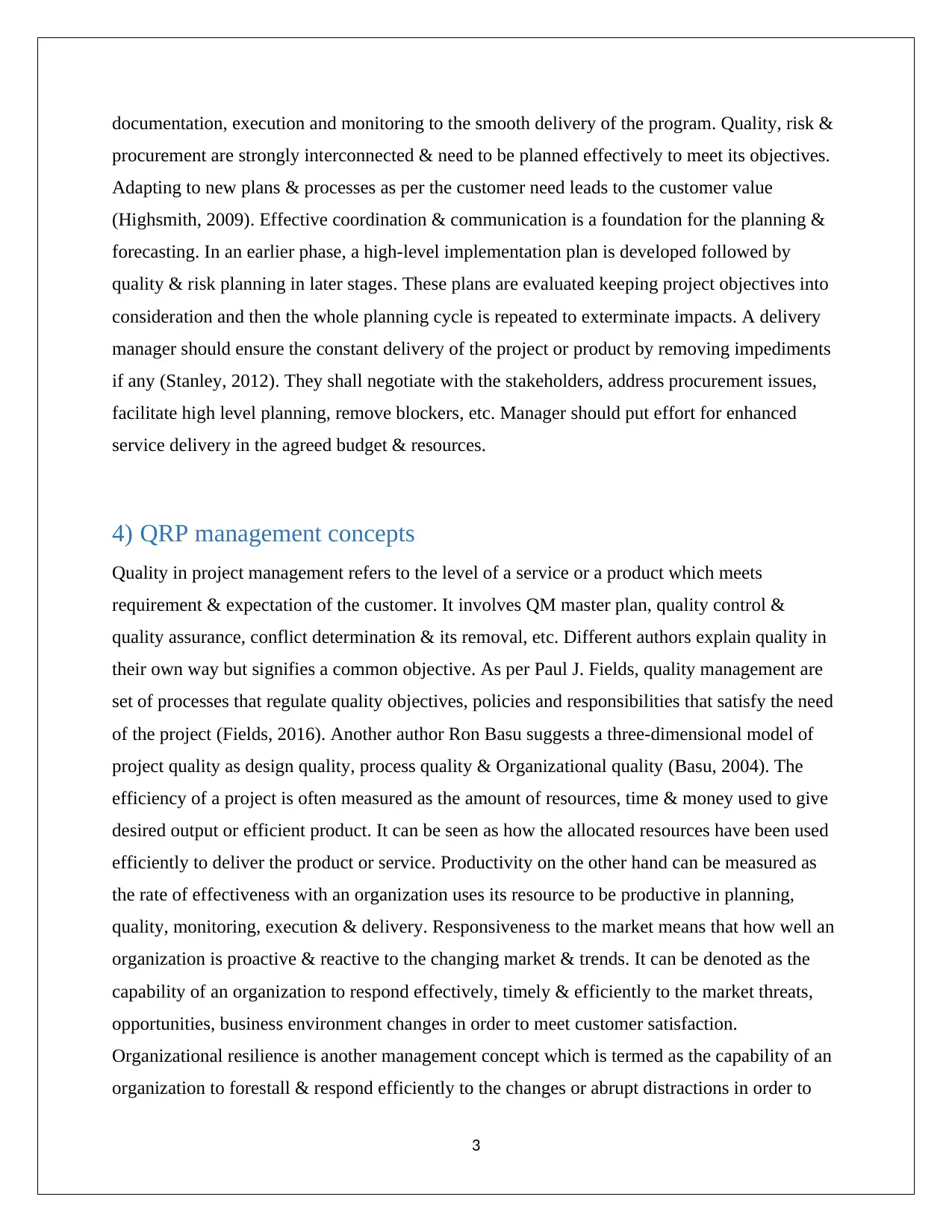
documentation, execution and monitoring to the smooth delivery of the program. Quality, risk &
procurement are strongly interconnected & need to be planned effectively to meet its objectives.
Adapting to new plans & processes as per the customer need leads to the customer value
(Highsmith, 2009). Effective coordination & communication is a foundation for the planning &
forecasting. In an earlier phase, a high-level implementation plan is developed followed by
quality & risk planning in later stages. These plans are evaluated keeping project objectives into
consideration and then the whole planning cycle is repeated to exterminate impacts. A delivery
manager should ensure the constant delivery of the project or product by removing impediments
if any (Stanley, 2012). They shall negotiate with the stakeholders, address procurement issues,
facilitate high level planning, remove blockers, etc. Manager should put effort for enhanced
service delivery in the agreed budget & resources.
4) QRP management concepts
Quality in project management refers to the level of a service or a product which meets
requirement & expectation of the customer. It involves QM master plan, quality control &
quality assurance, conflict determination & its removal, etc. Different authors explain quality in
their own way but signifies a common objective. As per Paul J. Fields, quality management are
set of processes that regulate quality objectives, policies and responsibilities that satisfy the need
of the project (Fields, 2016). Another author Ron Basu suggests a three-dimensional model of
project quality as design quality, process quality & Organizational quality (Basu, 2004). The
efficiency of a project is often measured as the amount of resources, time & money used to give
desired output or efficient product. It can be seen as how the allocated resources have been used
efficiently to deliver the product or service. Productivity on the other hand can be measured as
the rate of effectiveness with an organization uses its resource to be productive in planning,
quality, monitoring, execution & delivery. Responsiveness to the market means that how well an
organization is proactive & reactive to the changing market & trends. It can be denoted as the
capability of an organization to respond effectively, timely & efficiently to the market threats,
opportunities, business environment changes in order to meet customer satisfaction.
Organizational resilience is another management concept which is termed as the capability of an
organization to forestall & respond efficiently to the changes or abrupt distractions in order to
3
procurement are strongly interconnected & need to be planned effectively to meet its objectives.
Adapting to new plans & processes as per the customer need leads to the customer value
(Highsmith, 2009). Effective coordination & communication is a foundation for the planning &
forecasting. In an earlier phase, a high-level implementation plan is developed followed by
quality & risk planning in later stages. These plans are evaluated keeping project objectives into
consideration and then the whole planning cycle is repeated to exterminate impacts. A delivery
manager should ensure the constant delivery of the project or product by removing impediments
if any (Stanley, 2012). They shall negotiate with the stakeholders, address procurement issues,
facilitate high level planning, remove blockers, etc. Manager should put effort for enhanced
service delivery in the agreed budget & resources.
4) QRP management concepts
Quality in project management refers to the level of a service or a product which meets
requirement & expectation of the customer. It involves QM master plan, quality control &
quality assurance, conflict determination & its removal, etc. Different authors explain quality in
their own way but signifies a common objective. As per Paul J. Fields, quality management are
set of processes that regulate quality objectives, policies and responsibilities that satisfy the need
of the project (Fields, 2016). Another author Ron Basu suggests a three-dimensional model of
project quality as design quality, process quality & Organizational quality (Basu, 2004). The
efficiency of a project is often measured as the amount of resources, time & money used to give
desired output or efficient product. It can be seen as how the allocated resources have been used
efficiently to deliver the product or service. Productivity on the other hand can be measured as
the rate of effectiveness with an organization uses its resource to be productive in planning,
quality, monitoring, execution & delivery. Responsiveness to the market means that how well an
organization is proactive & reactive to the changing market & trends. It can be denoted as the
capability of an organization to respond effectively, timely & efficiently to the market threats,
opportunities, business environment changes in order to meet customer satisfaction.
Organizational resilience is another management concept which is termed as the capability of an
organization to forestall & respond efficiently to the changes or abrupt distractions in order to
3
Secure Best Marks with AI Grader
Need help grading? Try our AI Grader for instant feedback on your assignments.
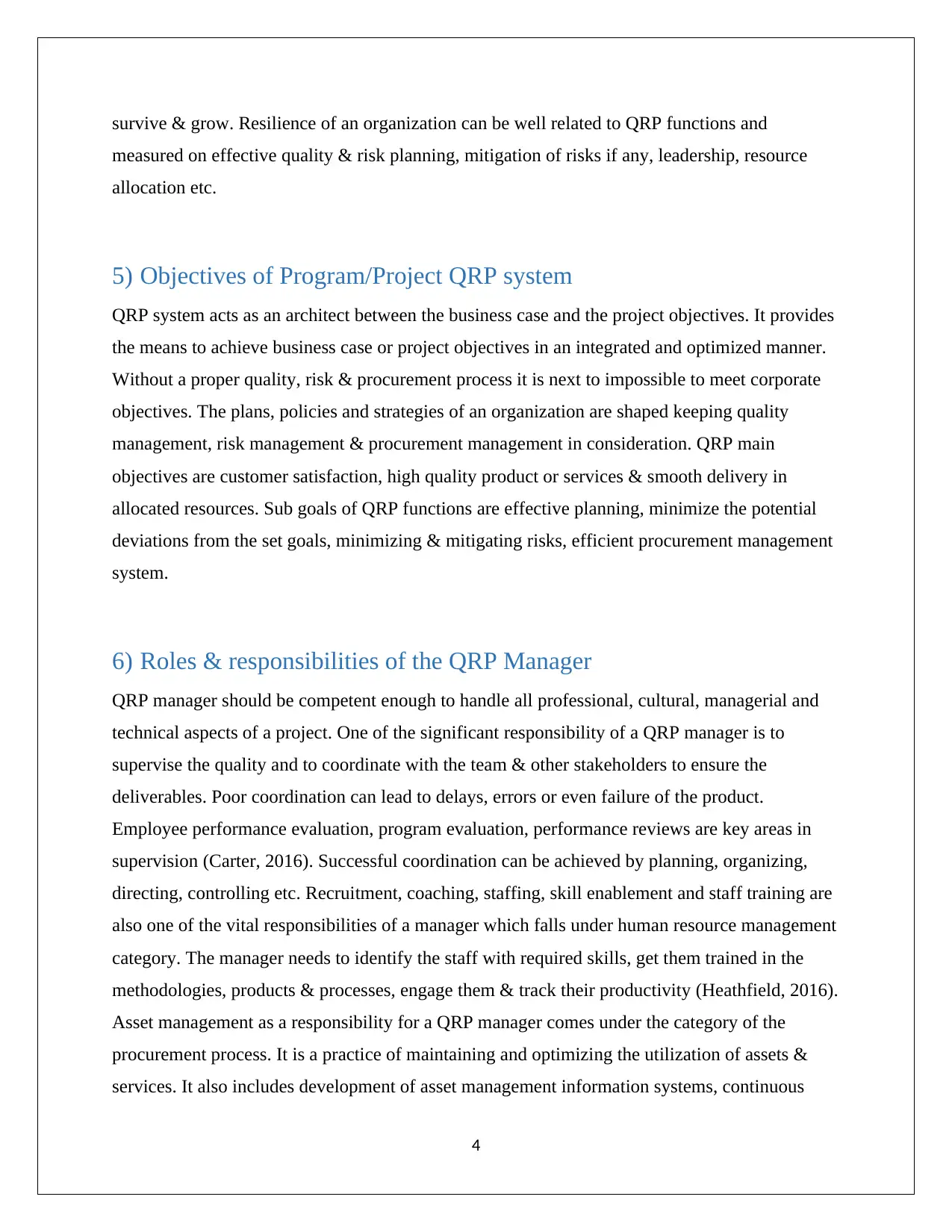
survive & grow. Resilience of an organization can be well related to QRP functions and
measured on effective quality & risk planning, mitigation of risks if any, leadership, resource
allocation etc.
5) Objectives of Program/Project QRP system
QRP system acts as an architect between the business case and the project objectives. It provides
the means to achieve business case or project objectives in an integrated and optimized manner.
Without a proper quality, risk & procurement process it is next to impossible to meet corporate
objectives. The plans, policies and strategies of an organization are shaped keeping quality
management, risk management & procurement management in consideration. QRP main
objectives are customer satisfaction, high quality product or services & smooth delivery in
allocated resources. Sub goals of QRP functions are effective planning, minimize the potential
deviations from the set goals, minimizing & mitigating risks, efficient procurement management
system.
6) Roles & responsibilities of the QRP Manager
QRP manager should be competent enough to handle all professional, cultural, managerial and
technical aspects of a project. One of the significant responsibility of a QRP manager is to
supervise the quality and to coordinate with the team & other stakeholders to ensure the
deliverables. Poor coordination can lead to delays, errors or even failure of the product.
Employee performance evaluation, program evaluation, performance reviews are key areas in
supervision (Carter, 2016). Successful coordination can be achieved by planning, organizing,
directing, controlling etc. Recruitment, coaching, staffing, skill enablement and staff training are
also one of the vital responsibilities of a manager which falls under human resource management
category. The manager needs to identify the staff with required skills, get them trained in the
methodologies, products & processes, engage them & track their productivity (Heathfield, 2016).
Asset management as a responsibility for a QRP manager comes under the category of the
procurement process. It is a practice of maintaining and optimizing the utilization of assets &
services. It also includes development of asset management information systems, continuous
4
measured on effective quality & risk planning, mitigation of risks if any, leadership, resource
allocation etc.
5) Objectives of Program/Project QRP system
QRP system acts as an architect between the business case and the project objectives. It provides
the means to achieve business case or project objectives in an integrated and optimized manner.
Without a proper quality, risk & procurement process it is next to impossible to meet corporate
objectives. The plans, policies and strategies of an organization are shaped keeping quality
management, risk management & procurement management in consideration. QRP main
objectives are customer satisfaction, high quality product or services & smooth delivery in
allocated resources. Sub goals of QRP functions are effective planning, minimize the potential
deviations from the set goals, minimizing & mitigating risks, efficient procurement management
system.
6) Roles & responsibilities of the QRP Manager
QRP manager should be competent enough to handle all professional, cultural, managerial and
technical aspects of a project. One of the significant responsibility of a QRP manager is to
supervise the quality and to coordinate with the team & other stakeholders to ensure the
deliverables. Poor coordination can lead to delays, errors or even failure of the product.
Employee performance evaluation, program evaluation, performance reviews are key areas in
supervision (Carter, 2016). Successful coordination can be achieved by planning, organizing,
directing, controlling etc. Recruitment, coaching, staffing, skill enablement and staff training are
also one of the vital responsibilities of a manager which falls under human resource management
category. The manager needs to identify the staff with required skills, get them trained in the
methodologies, products & processes, engage them & track their productivity (Heathfield, 2016).
Asset management as a responsibility for a QRP manager comes under the category of the
procurement process. It is a practice of maintaining and optimizing the utilization of assets &
services. It also includes development of asset management information systems, continuous
4
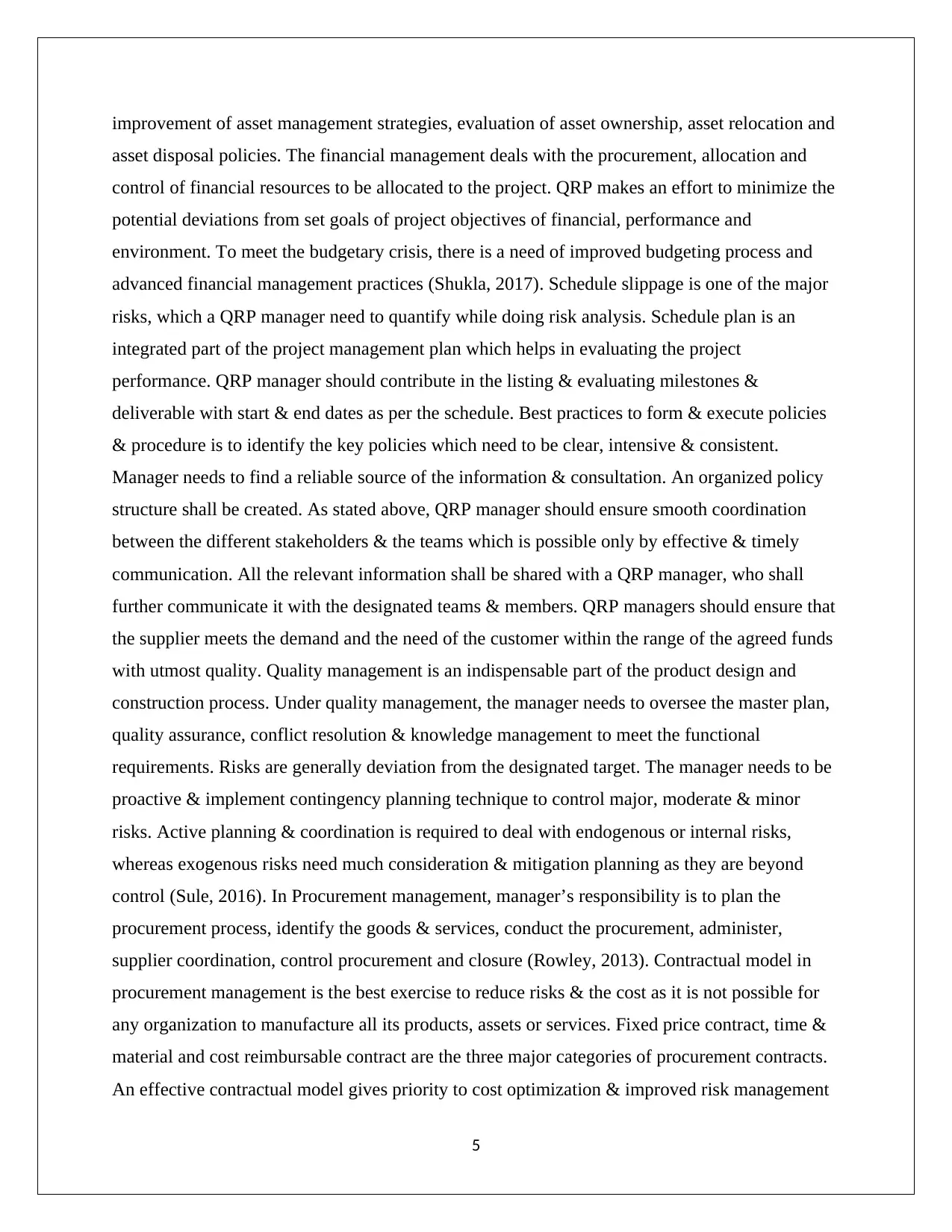
improvement of asset management strategies, evaluation of asset ownership, asset relocation and
asset disposal policies. The financial management deals with the procurement, allocation and
control of financial resources to be allocated to the project. QRP makes an effort to minimize the
potential deviations from set goals of project objectives of financial, performance and
environment. To meet the budgetary crisis, there is a need of improved budgeting process and
advanced financial management practices (Shukla, 2017). Schedule slippage is one of the major
risks, which a QRP manager need to quantify while doing risk analysis. Schedule plan is an
integrated part of the project management plan which helps in evaluating the project
performance. QRP manager should contribute in the listing & evaluating milestones &
deliverable with start & end dates as per the schedule. Best practices to form & execute policies
& procedure is to identify the key policies which need to be clear, intensive & consistent.
Manager needs to find a reliable source of the information & consultation. An organized policy
structure shall be created. As stated above, QRP manager should ensure smooth coordination
between the different stakeholders & the teams which is possible only by effective & timely
communication. All the relevant information shall be shared with a QRP manager, who shall
further communicate it with the designated teams & members. QRP managers should ensure that
the supplier meets the demand and the need of the customer within the range of the agreed funds
with utmost quality. Quality management is an indispensable part of the product design and
construction process. Under quality management, the manager needs to oversee the master plan,
quality assurance, conflict resolution & knowledge management to meet the functional
requirements. Risks are generally deviation from the designated target. The manager needs to be
proactive & implement contingency planning technique to control major, moderate & minor
risks. Active planning & coordination is required to deal with endogenous or internal risks,
whereas exogenous risks need much consideration & mitigation planning as they are beyond
control (Sule, 2016). In Procurement management, manager’s responsibility is to plan the
procurement process, identify the goods & services, conduct the procurement, administer,
supplier coordination, control procurement and closure (Rowley, 2013). Contractual model in
procurement management is the best exercise to reduce risks & the cost as it is not possible for
any organization to manufacture all its products, assets or services. Fixed price contract, time &
material and cost reimbursable contract are the three major categories of procurement contracts.
An effective contractual model gives priority to cost optimization & improved risk management
5
asset disposal policies. The financial management deals with the procurement, allocation and
control of financial resources to be allocated to the project. QRP makes an effort to minimize the
potential deviations from set goals of project objectives of financial, performance and
environment. To meet the budgetary crisis, there is a need of improved budgeting process and
advanced financial management practices (Shukla, 2017). Schedule slippage is one of the major
risks, which a QRP manager need to quantify while doing risk analysis. Schedule plan is an
integrated part of the project management plan which helps in evaluating the project
performance. QRP manager should contribute in the listing & evaluating milestones &
deliverable with start & end dates as per the schedule. Best practices to form & execute policies
& procedure is to identify the key policies which need to be clear, intensive & consistent.
Manager needs to find a reliable source of the information & consultation. An organized policy
structure shall be created. As stated above, QRP manager should ensure smooth coordination
between the different stakeholders & the teams which is possible only by effective & timely
communication. All the relevant information shall be shared with a QRP manager, who shall
further communicate it with the designated teams & members. QRP managers should ensure that
the supplier meets the demand and the need of the customer within the range of the agreed funds
with utmost quality. Quality management is an indispensable part of the product design and
construction process. Under quality management, the manager needs to oversee the master plan,
quality assurance, conflict resolution & knowledge management to meet the functional
requirements. Risks are generally deviation from the designated target. The manager needs to be
proactive & implement contingency planning technique to control major, moderate & minor
risks. Active planning & coordination is required to deal with endogenous or internal risks,
whereas exogenous risks need much consideration & mitigation planning as they are beyond
control (Sule, 2016). In Procurement management, manager’s responsibility is to plan the
procurement process, identify the goods & services, conduct the procurement, administer,
supplier coordination, control procurement and closure (Rowley, 2013). Contractual model in
procurement management is the best exercise to reduce risks & the cost as it is not possible for
any organization to manufacture all its products, assets or services. Fixed price contract, time &
material and cost reimbursable contract are the three major categories of procurement contracts.
An effective contractual model gives priority to cost optimization & improved risk management
5
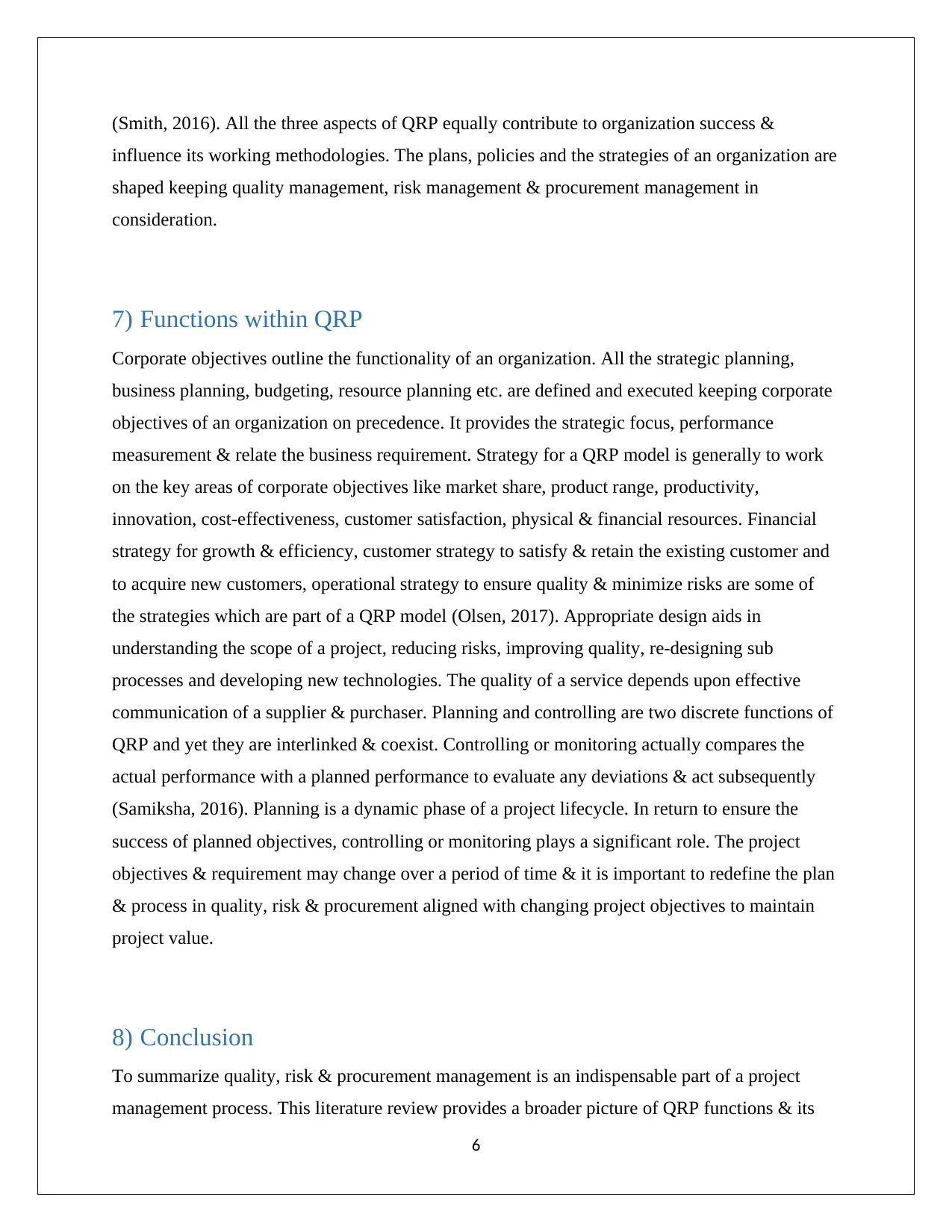
(Smith, 2016). All the three aspects of QRP equally contribute to organization success &
influence its working methodologies. The plans, policies and the strategies of an organization are
shaped keeping quality management, risk management & procurement management in
consideration.
7) Functions within QRP
Corporate objectives outline the functionality of an organization. All the strategic planning,
business planning, budgeting, resource planning etc. are defined and executed keeping corporate
objectives of an organization on precedence. It provides the strategic focus, performance
measurement & relate the business requirement. Strategy for a QRP model is generally to work
on the key areas of corporate objectives like market share, product range, productivity,
innovation, cost-effectiveness, customer satisfaction, physical & financial resources. Financial
strategy for growth & efficiency, customer strategy to satisfy & retain the existing customer and
to acquire new customers, operational strategy to ensure quality & minimize risks are some of
the strategies which are part of a QRP model (Olsen, 2017). Appropriate design aids in
understanding the scope of a project, reducing risks, improving quality, re-designing sub
processes and developing new technologies. The quality of a service depends upon effective
communication of a supplier & purchaser. Planning and controlling are two discrete functions of
QRP and yet they are interlinked & coexist. Controlling or monitoring actually compares the
actual performance with a planned performance to evaluate any deviations & act subsequently
(Samiksha, 2016). Planning is a dynamic phase of a project lifecycle. In return to ensure the
success of planned objectives, controlling or monitoring plays a significant role. The project
objectives & requirement may change over a period of time & it is important to redefine the plan
& process in quality, risk & procurement aligned with changing project objectives to maintain
project value.
8) Conclusion
To summarize quality, risk & procurement management is an indispensable part of a project
management process. This literature review provides a broader picture of QRP functions & its
6
influence its working methodologies. The plans, policies and the strategies of an organization are
shaped keeping quality management, risk management & procurement management in
consideration.
7) Functions within QRP
Corporate objectives outline the functionality of an organization. All the strategic planning,
business planning, budgeting, resource planning etc. are defined and executed keeping corporate
objectives of an organization on precedence. It provides the strategic focus, performance
measurement & relate the business requirement. Strategy for a QRP model is generally to work
on the key areas of corporate objectives like market share, product range, productivity,
innovation, cost-effectiveness, customer satisfaction, physical & financial resources. Financial
strategy for growth & efficiency, customer strategy to satisfy & retain the existing customer and
to acquire new customers, operational strategy to ensure quality & minimize risks are some of
the strategies which are part of a QRP model (Olsen, 2017). Appropriate design aids in
understanding the scope of a project, reducing risks, improving quality, re-designing sub
processes and developing new technologies. The quality of a service depends upon effective
communication of a supplier & purchaser. Planning and controlling are two discrete functions of
QRP and yet they are interlinked & coexist. Controlling or monitoring actually compares the
actual performance with a planned performance to evaluate any deviations & act subsequently
(Samiksha, 2016). Planning is a dynamic phase of a project lifecycle. In return to ensure the
success of planned objectives, controlling or monitoring plays a significant role. The project
objectives & requirement may change over a period of time & it is important to redefine the plan
& process in quality, risk & procurement aligned with changing project objectives to maintain
project value.
8) Conclusion
To summarize quality, risk & procurement management is an indispensable part of a project
management process. This literature review provides a broader picture of QRP functions & its
6
Paraphrase This Document
Need a fresh take? Get an instant paraphrase of this document with our AI Paraphraser
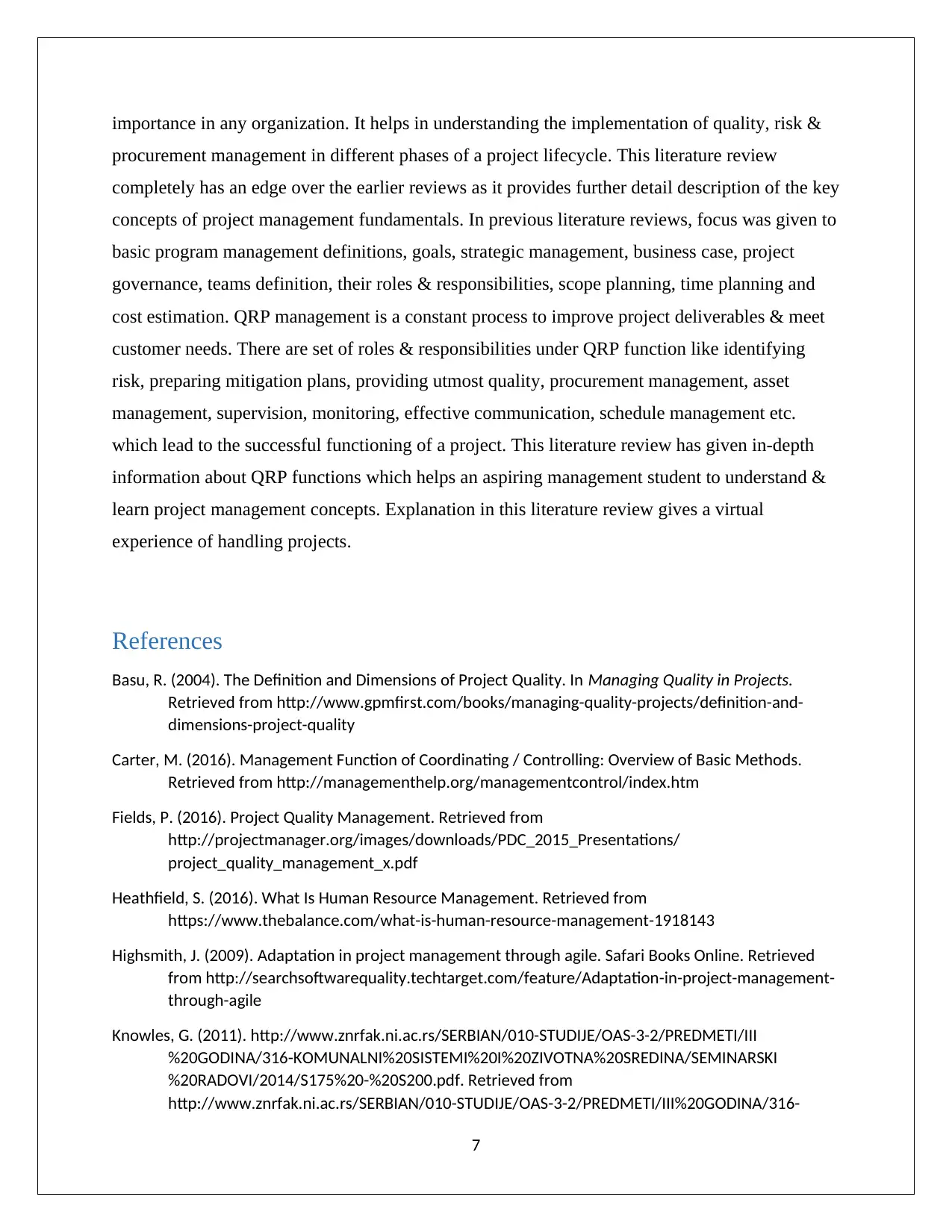
importance in any organization. It helps in understanding the implementation of quality, risk &
procurement management in different phases of a project lifecycle. This literature review
completely has an edge over the earlier reviews as it provides further detail description of the key
concepts of project management fundamentals. In previous literature reviews, focus was given to
basic program management definitions, goals, strategic management, business case, project
governance, teams definition, their roles & responsibilities, scope planning, time planning and
cost estimation. QRP management is a constant process to improve project deliverables & meet
customer needs. There are set of roles & responsibilities under QRP function like identifying
risk, preparing mitigation plans, providing utmost quality, procurement management, asset
management, supervision, monitoring, effective communication, schedule management etc.
which lead to the successful functioning of a project. This literature review has given in-depth
information about QRP functions which helps an aspiring management student to understand &
learn project management concepts. Explanation in this literature review gives a virtual
experience of handling projects.
References
Basu, R. (2004). The Definition and Dimensions of Project Quality. In Managing Quality in Projects.
Retrieved from http://www.gpmfirst.com/books/managing-quality-projects/definition-and-
dimensions-project-quality
Carter, M. (2016). Management Function of Coordinating / Controlling: Overview of Basic Methods.
Retrieved from http://managementhelp.org/managementcontrol/index.htm
Fields, P. (2016). Project Quality Management. Retrieved from
http://projectmanager.org/images/downloads/PDC_2015_Presentations/
project_quality_management_x.pdf
Heathfield, S. (2016). What Is Human Resource Management. Retrieved from
https://www.thebalance.com/what-is-human-resource-management-1918143
Highsmith, J. (2009). Adaptation in project management through agile. Safari Books Online. Retrieved
from http://searchsoftwarequality.techtarget.com/feature/Adaptation-in-project-management-
through-agile
Knowles, G. (2011). http://www.znrfak.ni.ac.rs/SERBIAN/010-STUDIJE/OAS-3-2/PREDMETI/III
%20GODINA/316-KOMUNALNI%20SISTEMI%20I%20ZIVOTNA%20SREDINA/SEMINARSKI
%20RADOVI/2014/S175%20-%20S200.pdf. Retrieved from
http://www.znrfak.ni.ac.rs/SERBIAN/010-STUDIJE/OAS-3-2/PREDMETI/III%20GODINA/316-
7
procurement management in different phases of a project lifecycle. This literature review
completely has an edge over the earlier reviews as it provides further detail description of the key
concepts of project management fundamentals. In previous literature reviews, focus was given to
basic program management definitions, goals, strategic management, business case, project
governance, teams definition, their roles & responsibilities, scope planning, time planning and
cost estimation. QRP management is a constant process to improve project deliverables & meet
customer needs. There are set of roles & responsibilities under QRP function like identifying
risk, preparing mitigation plans, providing utmost quality, procurement management, asset
management, supervision, monitoring, effective communication, schedule management etc.
which lead to the successful functioning of a project. This literature review has given in-depth
information about QRP functions which helps an aspiring management student to understand &
learn project management concepts. Explanation in this literature review gives a virtual
experience of handling projects.
References
Basu, R. (2004). The Definition and Dimensions of Project Quality. In Managing Quality in Projects.
Retrieved from http://www.gpmfirst.com/books/managing-quality-projects/definition-and-
dimensions-project-quality
Carter, M. (2016). Management Function of Coordinating / Controlling: Overview of Basic Methods.
Retrieved from http://managementhelp.org/managementcontrol/index.htm
Fields, P. (2016). Project Quality Management. Retrieved from
http://projectmanager.org/images/downloads/PDC_2015_Presentations/
project_quality_management_x.pdf
Heathfield, S. (2016). What Is Human Resource Management. Retrieved from
https://www.thebalance.com/what-is-human-resource-management-1918143
Highsmith, J. (2009). Adaptation in project management through agile. Safari Books Online. Retrieved
from http://searchsoftwarequality.techtarget.com/feature/Adaptation-in-project-management-
through-agile
Knowles, G. (2011). http://www.znrfak.ni.ac.rs/SERBIAN/010-STUDIJE/OAS-3-2/PREDMETI/III
%20GODINA/316-KOMUNALNI%20SISTEMI%20I%20ZIVOTNA%20SREDINA/SEMINARSKI
%20RADOVI/2014/S175%20-%20S200.pdf. Retrieved from
http://www.znrfak.ni.ac.rs/SERBIAN/010-STUDIJE/OAS-3-2/PREDMETI/III%20GODINA/316-
7
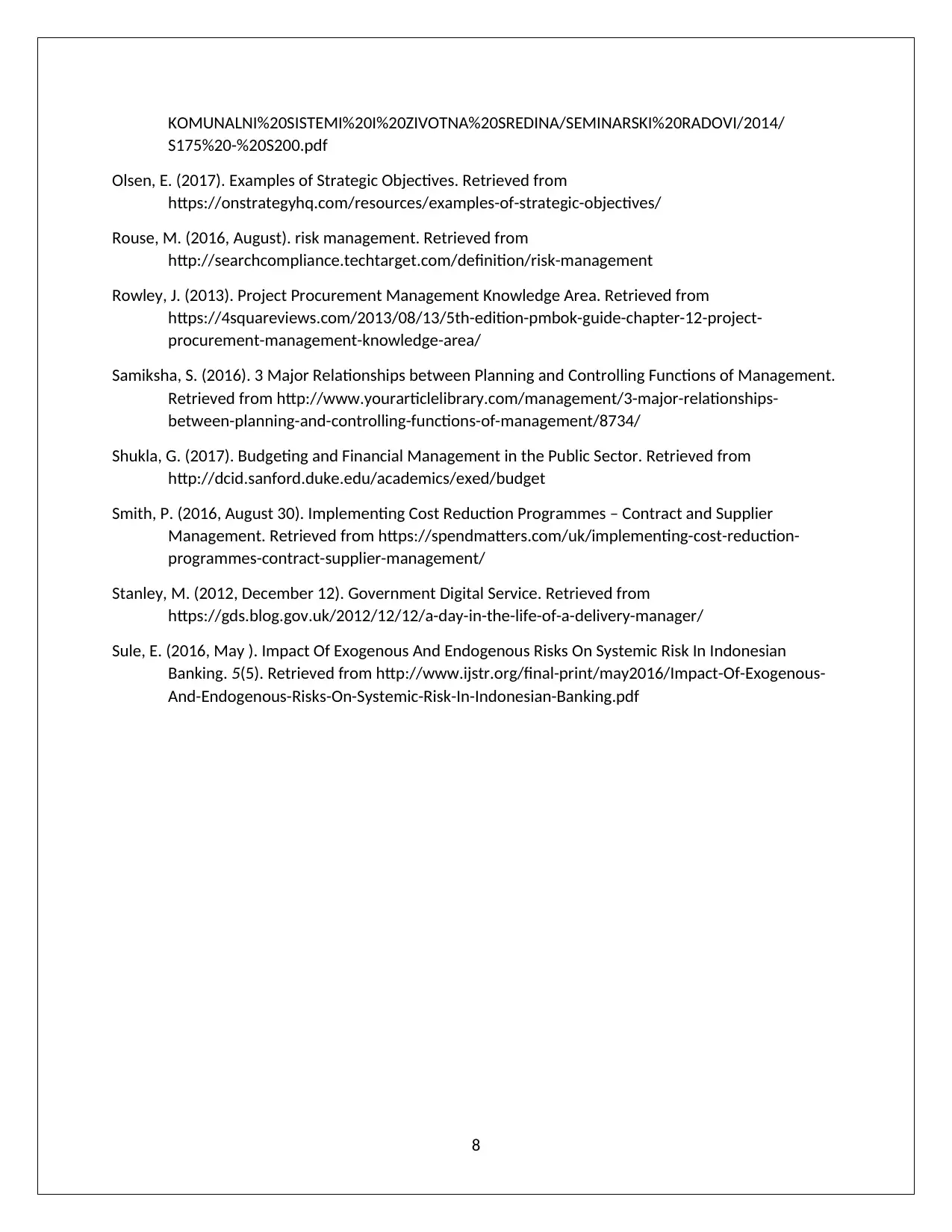
KOMUNALNI%20SISTEMI%20I%20ZIVOTNA%20SREDINA/SEMINARSKI%20RADOVI/2014/
S175%20-%20S200.pdf
Olsen, E. (2017). Examples of Strategic Objectives. Retrieved from
https://onstrategyhq.com/resources/examples-of-strategic-objectives/
Rouse, M. (2016, August). risk management. Retrieved from
http://searchcompliance.techtarget.com/definition/risk-management
Rowley, J. (2013). Project Procurement Management Knowledge Area. Retrieved from
https://4squareviews.com/2013/08/13/5th-edition-pmbok-guide-chapter-12-project-
procurement-management-knowledge-area/
Samiksha, S. (2016). 3 Major Relationships between Planning and Controlling Functions of Management.
Retrieved from http://www.yourarticlelibrary.com/management/3-major-relationships-
between-planning-and-controlling-functions-of-management/8734/
Shukla, G. (2017). Budgeting and Financial Management in the Public Sector. Retrieved from
http://dcid.sanford.duke.edu/academics/exed/budget
Smith, P. (2016, August 30). Implementing Cost Reduction Programmes – Contract and Supplier
Management. Retrieved from https://spendmatters.com/uk/implementing-cost-reduction-
programmes-contract-supplier-management/
Stanley, M. (2012, December 12). Government Digital Service. Retrieved from
https://gds.blog.gov.uk/2012/12/12/a-day-in-the-life-of-a-delivery-manager/
Sule, E. (2016, May ). Impact Of Exogenous And Endogenous Risks On Systemic Risk In Indonesian
Banking. 5(5). Retrieved from http://www.ijstr.org/final-print/may2016/Impact-Of-Exogenous-
And-Endogenous-Risks-On-Systemic-Risk-In-Indonesian-Banking.pdf
8
S175%20-%20S200.pdf
Olsen, E. (2017). Examples of Strategic Objectives. Retrieved from
https://onstrategyhq.com/resources/examples-of-strategic-objectives/
Rouse, M. (2016, August). risk management. Retrieved from
http://searchcompliance.techtarget.com/definition/risk-management
Rowley, J. (2013). Project Procurement Management Knowledge Area. Retrieved from
https://4squareviews.com/2013/08/13/5th-edition-pmbok-guide-chapter-12-project-
procurement-management-knowledge-area/
Samiksha, S. (2016). 3 Major Relationships between Planning and Controlling Functions of Management.
Retrieved from http://www.yourarticlelibrary.com/management/3-major-relationships-
between-planning-and-controlling-functions-of-management/8734/
Shukla, G. (2017). Budgeting and Financial Management in the Public Sector. Retrieved from
http://dcid.sanford.duke.edu/academics/exed/budget
Smith, P. (2016, August 30). Implementing Cost Reduction Programmes – Contract and Supplier
Management. Retrieved from https://spendmatters.com/uk/implementing-cost-reduction-
programmes-contract-supplier-management/
Stanley, M. (2012, December 12). Government Digital Service. Retrieved from
https://gds.blog.gov.uk/2012/12/12/a-day-in-the-life-of-a-delivery-manager/
Sule, E. (2016, May ). Impact Of Exogenous And Endogenous Risks On Systemic Risk In Indonesian
Banking. 5(5). Retrieved from http://www.ijstr.org/final-print/may2016/Impact-Of-Exogenous-
And-Endogenous-Risks-On-Systemic-Risk-In-Indonesian-Banking.pdf
8
1 out of 9
Related Documents
Your All-in-One AI-Powered Toolkit for Academic Success.
+13062052269
info@desklib.com
Available 24*7 on WhatsApp / Email
![[object Object]](/_next/static/media/star-bottom.7253800d.svg)
Unlock your academic potential
© 2024 | Zucol Services PVT LTD | All rights reserved.





